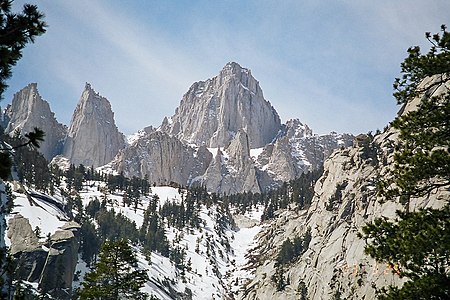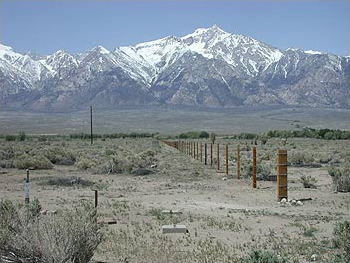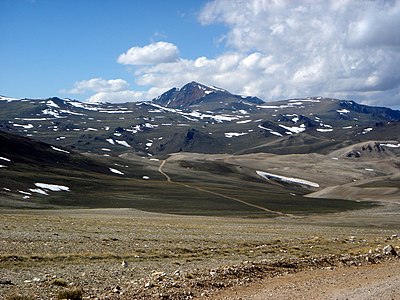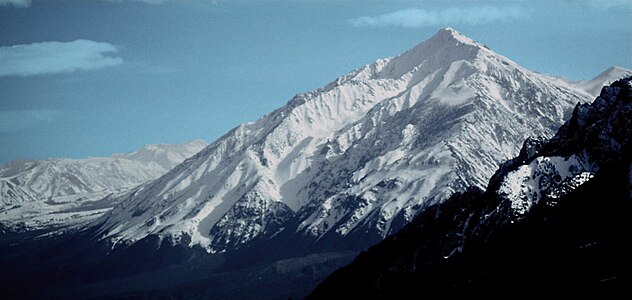List of mountain peaks of California
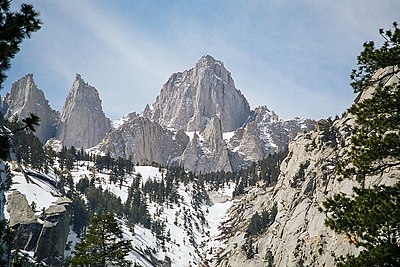
This article comprises three sortable tables of major mountain peaks[1] of the U.S. State of California.
The summit of a mountain or hill may be measured in three principal ways:
- The topographic elevation of a summit measures the height of the summit above a geodetic sea level.[2][3] The first table below ranks the 50 highest major summits of California by elevation.
- The topographic prominence of a summit is a measure of how high the summit rises above its surroundings.[4][3] The second table below ranks the 50 most prominent summits of California.
- The topographic isolation (or radius of dominance) of a summit measures how far the summit lies from its nearest point of equal elevation.[5] The third table below ranks the 50 most isolated major summits of California.
Highest major summits
Of the highest major summits of California, 16 peaks exceed 4000 meters (13,123 feet) elevation and 46 peaks exceed 3000 meters (9843 feet) elevation.
Most prominent summits
Of the most prominent summits of California, only Mount Whitney exceeds 3000 meters (9843 feet) of topographic prominence, five peaks exceed 2000 meters (6562 feet), nine peaks are ultra-prominent summits with more than 1500 meters (4921 feet), and 35 peaks exceed 1000 meters (3281 feet) of topographic prominence.
Most isolated major summits
Of the most isolated major summits of California, Mount Whitney exceeds 2000 kilometers (1243 miles) of topographic isolation, Mount Shasta exceeds 500 kilometers (310.7 miles), four peaks exceed 200 kilometers (124.3 miles), and nine peaks exceed 100 kilometers (62.14 miles) of topographic isolation.
Gallery
-
Mount Whitney is the highest summit of the Sierra Nevada, the State of California, and the contiguous United States.
-
Mount Williamson is the second highest mountain peak of California.
-
White Mountain Peak is the highest summit of the White Mountains and is the highest point within the Great Basin.
-
The stratovolcano Mount Shasta is the second most topographically prominent California mountain peak.
-
Mount Humphreys in the Sierra Nevada.
-
Mount Darwin is the highest summit of the Evolution Peaks of the Sierra Nevada.
-
Mount Tom in the Sierra Nevada.
-
San Gorgonio Mountain is the highest summit of the San Bernardino Mountains and the third most topographically isolated California peak.
-
Telescope Peak is the highest summit of the Panamint Range.
-
San Jacinto Peak is the highest summit of the San Jacinto Mountains.
-
Mount San Antonio is the highest summit of the San Gabriel Mountains.
See also
- List of mountain peaks of North America
- List of mountain peaks of Greenland
- List of mountain peaks of Canada
- List of mountain peaks of the Rocky Mountains
- List of mountain peaks of the United States
- List of mountain peaks of Alaska
- List of mountain peaks of Arizona
- List of mountain peaks of California
- List of mountain peaks of Colorado
- List of mountain peaks of Hawaiʻi
- List of mountain peaks of Idaho
- List of mountain peaks of Montana
- List of mountain peaks of Nevada
- List of mountain peaks of New Mexico
- List of mountain peaks of Oregon
- List of mountain peaks of Utah
- List of mountain peaks of Washington
- List of mountain peaks of Wyoming
- List of mountain peaks of México
- List of mountain peaks of Central America
- List of mountain peaks of the Caribbean
- California
- Physical geography
References
- ^ This article defines a significant summit as a summit with at least 100 meters (328.1 feet) of topographic prominence, and a major summit as a summit with at least 500 meters (1640 feet) of topographic prominence. All summits in this article have at least 500 meters of topographic prominence. An ultra-prominent summit is a summit with at least 1500 meters (4921 feet) of topographic prominence.
- ^ All elevations in this article include an elevation adjustment from the National Geodetic Vertical Datum of 1929 (NGVD 29) to the North American Vertical Datum of 1988 (NAVD 88). For further information, please see this United States National Geodetic Survey note.
- ^ a b If the elevation or prominence of a summit is calculated as a range of values, the arithmetic mean is shown.
- ^ The topographic prominence of a summit is the topographic elevation difference between the summit and its highest or key col to a higher summit. The summit may be near its key col or quite far away. The key col for Denali in Alaska is the Isthmus of Rivas in Nicaragua, 7642 kilometers (4749 miles) away.
- ^ The topographic isolation of a summit is the great-circle distance to its nearest point of equal elevation.

